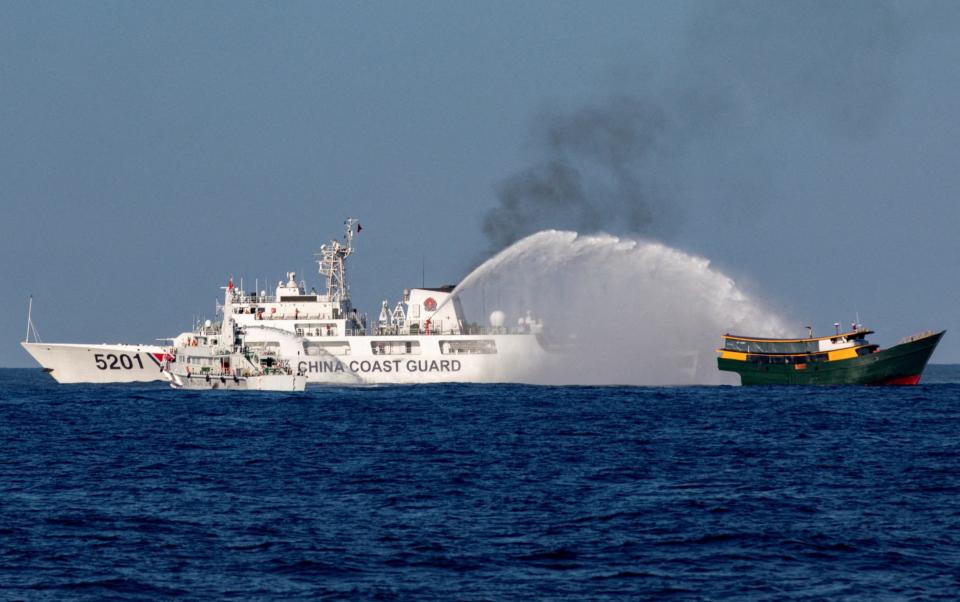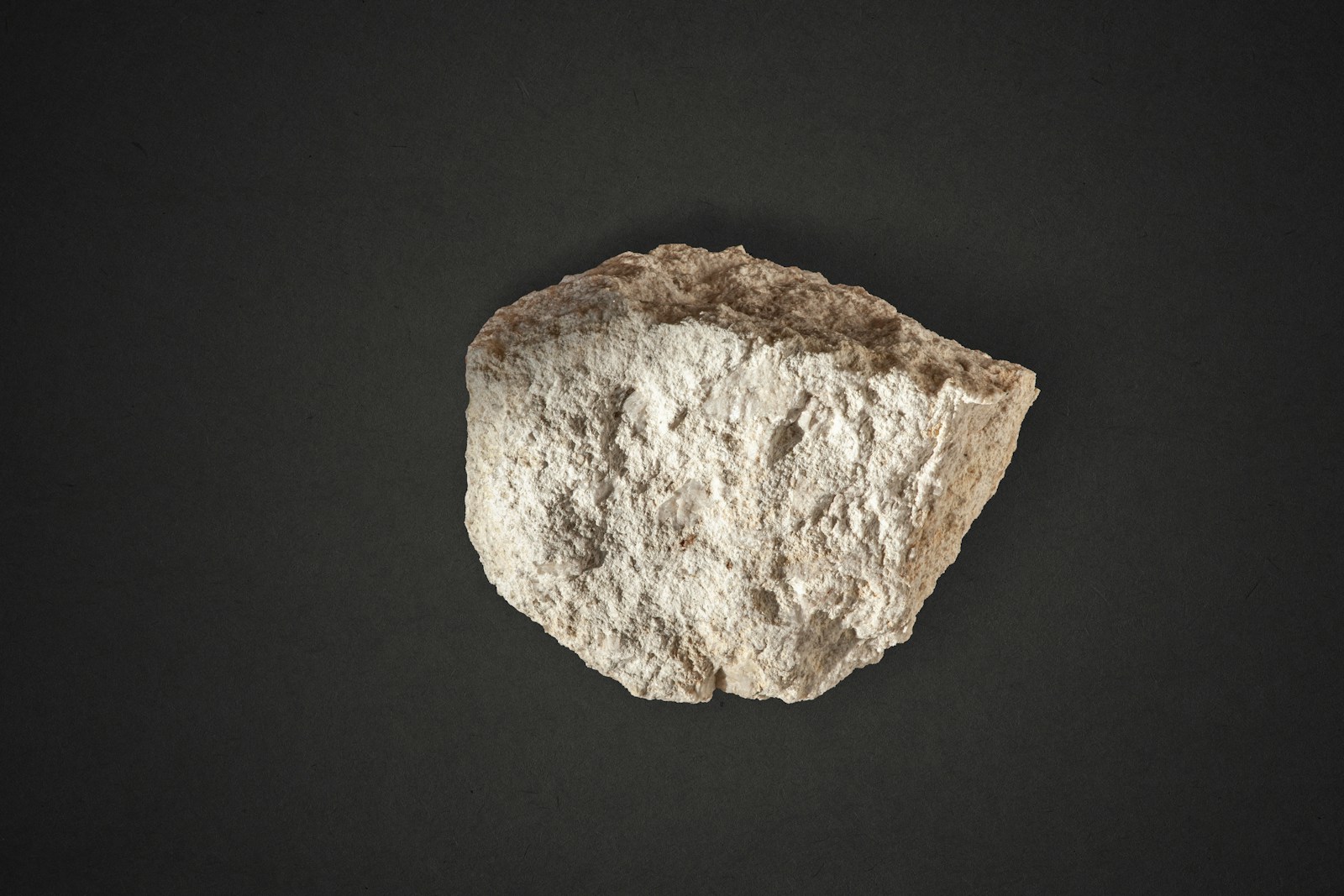Nicola Smith, The Telegraph’s Asia Correspondent, was onboard a Philippine Coast Guard ship accompanying fishermen near the disputed Scarborough Shoal in the South China Sea on Tuesday when her vessel was attacked by the China Coast Guard
I was standing on the deck of a Philippine Coast Guard ship when a Chinese vessel opened fire with its water cannon.
The powerful jets of water initially looped into the air – but within seconds they had begun to batter our craft, pounding down on the stern of the ship.
There were moments of chaos: Filipino crew members dived for cover, screaming instructions to each other.
A small team of journalists, including myself, ducked inside a narrow passageway as water sprayed in all directions. The crew dragged the most precious bits of equipment – and the ship’s American Bulldog named Six – under the steel roof of the passageway.
For five minutes the Chinese ships circled around our ship, which took evasive action to try and weave between them, while constantly firing the water cannon.
This was a rare first-hand example of the kind of intimidation tactics Beijing has deployed to prevent Filippino authorities from accessing the Scarborough Shoal, a valuable fishing territory that falls within the Phillippines’s borders but China now lays claim to.
In the safety of the passageway, all you could hear was the thundering of the water and more frantic shouts of the crew.
The ship’s canopy broke in the intensity of the strike and the vessel took two more direct hits under a sustained assault of about half an hour.
Then after another half an hour our ship turned around and returned to join a smaller ship about 12 nautical miles behind us.
The Telegraph was on board the 40-metre-long Filipino ship, BRP Bagacay, which was tasked with protecting the BRP Datu Bankaw, delivering supplies of fuel and food to local fishermen.
The Datu Bankaw was also penetrated by a water cannon and rammed on its side by a Chinese ship, partially flooding its interior. Its radar was damaged in the confrontation.
Chinese authorities are working aggressively to deny Filipino fishing communities access to the shoal, which on Tuesday was ringed by a floating barrier.
In carrying out the mission on Monday, Manila was signalling to Beijing its intent to assert its claims over the Scarborough Shoal, which is claimed by both countries but lies much closer to the Philippines.
The shoal, a chain of reefs and rocks covering 58 square miles, including an inner lagoon, was administered by the Philippines until 2012 when China effectively seized control after a standoff between Chinese and Philippine vessels.
The international incident led to a landmark international arbitration case brought by Manila that successfully challenged Beijing’s historical claims to most of the South China Sea, including the shoal.
The International Court of Arbitration in the Hague ruled in 2016 that China’s claims over the entire resource-rich South China Sea were invalid.
But Beijing has ignored the court’s decision, continuing to beef up its patchwork of military outposts on artificial islands, while dispatching its so-called maritime militia, coast guard vessels and navy to intimidate and squeeze out rival Southeast Asian claimants to the waters and its features.
Its growing presence in the strategic South China Sea has triggered suspicion that it is working to seize control of access to crucial global shipping routes in international waters.
Recent muscle-flexing between Beijing and Manila, which is strengthening its alliance with the United States under Philippine president Ferdinand Marcos, has raised fears that a maritime clash between the two nations could escalate into a much wider international conflict.
Soaked by spray and bunkering down by the door to the ship’s deck to evade the high-powered water jet, I could witness first-hand how dangerous behaviour by the China Coast Guard could trigger an accident that could quickly escalate.
The journalists and Filipino crew huddled in the dark narrow corridor as the jet stream pounded heavily on the exterior of the ship, at its peak resembling a tropical storm.
It was alarming to see the lengths the Chinese coast guard flotilla went to in order to prevent access to the shoal.
All morning, they had played a high-stakes game of maritime cat and mouse as they tailed the two Filipino ships for about three hours. The first Chinese coast guard ship was spotted as dawn broke just after 5am.
As the Filipino convoy came within 24 nautical miles of the shoal, the chase intensified, with China pursuing at high speeds and intermittently cutting directly in front of the ship’s bow.
There were occasions when the Chinese veered so close – within about 20 or 30 metres – that the Filipino captains had to slow down or take evasive action to avoid a collision. Sailors waited on standby on deck, holding orange buoys strung together to be deployed as buffers.
Crews on either side observed each other at close range. On the bridge of the Filipino coast guard vessel, the officers stared intently across at their counterparts with binoculars, some filming the encounter. The Chinese crew members reciprocated.
The Chinese vessels’ purpose was evidently to block their path and to isolate the two Filipino ships, and to do so, they relentlessly performed dangerous and intimidating manoeuvres to try to force them back towards the coast.
The Filipinos were outnumbered, pursued by at least five coast guard ships, while a Chinese navy ship sailed parallel and watched from a distance.

Our crew have been in radio contact with the China Coast Guard, requesting them to back off and also reading out a statement asserting the Philippines’s claims to the shoal.
As the reef neared, the Bagacay accelerated, attempting to take the heat from the Datu Bankaw, which had put out a call to nearby fishermen to collect its supplies.
The China Coast Guard eventually pulled back and as the Bagacay came within 1,000 yards of the southern entrance of the shoal, it spotted a 380-metre barrier of white buoys – yet another obstacle in its path.
The sea was unusually calm as the crew dispatched a drone to examine the artificial boundary. It was then that the Chinese pounced, attacking the ship with water cannons from both sides.
The Philippine coast guard condemned China’s actions in a statement.
It said it had assigned its vessel to “carry out a legitimate maritime patrol in the waters near Bajo De Masinloc” with the “primary objective to distribute fuel and food supplies” to support fishermen.
“During the patrol, the Philippine vessels encountered dangerous manoeuvres and obstruction from four China Coast Guard vessels and six Chinese maritime militia vessels,” it added.
The damage by the cannons “serves as evidence of the forceful water pressure used by the China Coast Guard in their harassment of the Philippine vessels,” said the Philippine Coast Guard.
The confrontation, although shocking, was not a rare incident in the South China Sea, where Chinese vessels have frequently deployed water cannons, lasers, and other bullying tactics against the Philippines and any other ships they believe to be intruding on their territory.
The Philippines praised its coast guard for standing its ground. “They were not deterred and will persist in carrying out their legitimate operations to support Filipino fishermen and ensure their safety.”
The convoy later that day turned back towards port owing to the damage to the supply vessel.
Their crews – this time – were unscathed, but such incidents are a risk they must frequently face in the battle to control the strategic South China Sea, on the front line of tensions that many fear could spark the next international conflict.
Broaden your horizons with award-winning British journalism. Try The Telegraph free for 3 months with unlimited access to our award-winning website, exclusive app, money-saving offers and more.










